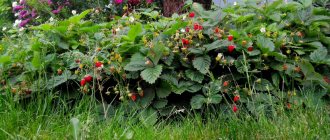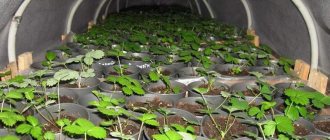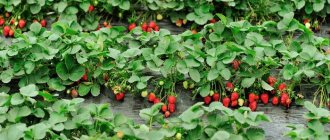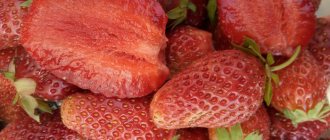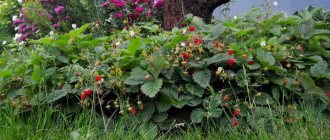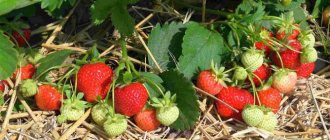If you are just going to plant strawberries or can’t achieve a good harvest, or are looking for the ideal variety, or just want to know everything about growing this crop, read the material from experienced breeder Mikhail Kachalkin.
He comprehensively answered all the questions that arise for both beginners and experienced gardeners in the process of selecting, planting and caring for garden strawberries. He also shared his secrets and proven varieties.
Mikhail Kachalkin – Candidate of Agricultural Sciences, breeder, director of the Experimental Breeding Nursery LLC.
How to choose the size of a strawberry bed
At your discretion. But practice shows that a width of 90 cm is convenient for all work on caring for strawberries. How many bushes do you need? If you just eat, then 15-20 plants are enough for a family of three. For each plant, allocate approximately 0.5 sq.m. in the garden bed.
And if there are a lot of berry lovers, and even preparations are planned, then you probably need 50-60 plants. Focus on a yield of 0.5 kg per bush. Moreover, using the earliest and latest varieties, you can stretch the supply of fresh berries for 30-40 days, from the end of June to the beginning of August. And in the case of remontant varieties - from early June to mid-October. But keep in mind that a planting pattern of 50x50 cm is too small, 60x60 cm is better, so that there is good lighting and ventilation on all sides.
Biological features
This perennial plant consists of aboveground and underground parts.
Underground part
The underground part consists of a branched fibrous root system and a modified stem with bud primordia, from which new above-ground stems-horns with an apical bud and overgrowing roots grow. Over time, the bush grows, there are more shoots-horns, and there are also more roots and leaves with flower stalks and berries formed on them. A well-developed bush can have up to 25-30 shoots-horns.
Overground
It has no central stem and consists of three types of shoots:
- Annual shoots-horns with a central and axillary bud from which shoots, peduncles and tendrils will grow the next year.
- Creeping tendril shoots that are needed for vegetative propagation.
- Peduncles formed from the central bud of the horn, on which fruiting occurs.
What fertilizers do strawberries need, and is it possible to do without them?
Strawberries do not like a lot of fertilizers, but they also cannot be grown without them. Or rather, it is possible, but you will need a lot of manure humus, compost or vermicompost. Moreover, it should be taken into account that many nutrient soils that are sold in garden centers contain mineral fertilizers.
So, “mineral water”, preferably imported chlorine-free water, for example, New Universal in a dose of 50-70 g per 1 sq.m. We dig everything well, select the weeds, mix the mineral water and compost with peat and form a bed 20-25 cm high. We plant the seedlings in a week or two, or preferably three, after the earth has settled a little.
Why do many people cover their garden beds with black film?
Variety Evis Delight
We advise you to purchase a film or non-woven material of black color, with a density of 80 g/sq.m. When growing strawberries, it allows you to solve several problems at once. First of all, it is protection from weeds, which with regular watering are a real disaster. Secondly, the soil under the shelter will dry out less and warm up better, and this is very good for plants.
And finally, the berries will lie on clean material, which means they will rot less. In addition, the tendrils that form at the beginning of flowering will not be able to take root on the black tissue, and you will not have to tear them out of the ground - you will simply cut them off several times during the season: if they are not removed, they will “eat” up to 30% of the harvest.
If you want to breed a certain variety, then young rosettes can be rooted in pots, and then separated from the mother plant and grown in a greenhouse. Just keep in mind that plants in pots require daily watering.
Watering the plant
It is important to decide how to water strawberries in open ground. If there is little precipitation on the soil during the season, and there is a dry spring and summer, then we constantly water it abundantly, but not excessively, after the plant is planted and intensive leaf growth and flowering have begun. But you need to remember that when strawberries bloom, they don’t water them.
After the rains, with sufficient moisture, the strawberries will develop normally. In case of drought, water in the evening or early morning. If there is not enough moisture, the berries will grow sour.
It is important to know. The ground around the planted bush should be watered and sprinkled with humus or dry soil. Over the next 2 weeks, the soil is gradually moistened so that the roots of the plant take root faster. In the future, the beds are watered every other day.
If strawberries are not grown in greenhouses, then how to increase the yield of strawberries in open ground - they are grown under a film, dark or light. If we line a film or mulch of dry grass, peat, or chopped straw under the rosette, the berries will ripen 7-10 days earlier, and weeds will practically not grow.
When using hydroponic beds, abundant and frequent watering is required with a special solution containing macro- and microelements. It is easier to grow a crop using a drip irrigation system and a base with an NFT nutrient layer. The substrate can be a peat mixture, mineral wool or coconut, previously placed in film. With drip irrigation, the liquid nutrient mass gets under the root. Light does not penetrate the film, but the plant is provided with air exchange.
If NFT is used, then the nutrient solution circulates, all the liquid accumulates in a thin layer at the bottom of the plastic box. It is supplied through hoses connected to a tank containing substances to power the outlets. First, the sockets are placed in plastic cups with holes. The glasses are very close to the layer of nutrient liquid. As they grow, the roots are immersed in the substance coming from the tank. The plant feels good, develops, blooms thickly and bears fruit.
If you grow remontant strawberries at home during cold periods, you need to constantly illuminate the plant for 12-20 hours a day with a lamp with a power of up to 60,000 lumens. You should constantly check the humidity and keep it to 60-70%, but not higher, so that fungi do not develop.
Caring for garden strawberries after planting
First of all, high-quality regular watering is necessary. Shading promotes survival of bushes very well. This can be old non-woven material or simply tufts of grass or hay placed on top of planted plants for 3-4 days. They will protect the seedlings from the sun and wind. If it is the beginning of May, then you can simply throw non-woven material on top of the bushes.
If you plant seedlings in mid-May or later, then a frame is already needed (as for cucumbers), because Plants may burn under non-woven material. In this form (under the frame) they can be kept until the beginning of June, watering and opening at least once a week. It is very useful to pick off the first flowers, then the plants will be well formed and will subsequently give you a bountiful harvest. Before flowering, remove the cover, because flowers must be accessible to bees.
Agricultural technology for planting in open ground: time and depth
Seedlings can be planted in early spring, as soon as the soil thaws, and continue until flower stalks begin to emerge. At this time, young plants take root well and can produce the first berries, but for better growth of the young bush, it is still better to remove the first flower stalks. By winter, a good, powerful plant is formed, ready to bear fruit the next year.
Can be planted at the end of summer, until the beginning of September. The disadvantage of this period is that with rainy and cold late summer and early autumn, strawberries will not have time to form a good root system, which can have a bad effect on the wintering of young bushes.
Caring for remontant strawberries
If you planted remontant strawberries, you will have berries almost until the end of October. Therefore, in mid-August, you can again build a shelter from non-woven material, but with good end ventilation.
In addition, keep in mind that remontant strawberries are more demanding in terms of watering and fertilizing. During the season, it is enough to feed the strawberries twice: once in the spring, in early May, and then after harvesting. A complex mineral fertilizer such as Kemira Universal is suitable. If you are against mineral fertilizers, use an infusion of chicken droppings or manure, just do not overdo the concentration.
Preparation of seedlings
Strawberries are an unpretentious and undemanding plant, so they can be grown in open ground. The main thing is to pay attention to the composition of the soil. The best option is soil made from black soil and ash. Before planting berries, you need to prepare the soil in advance.
For a good harvest, you need to purchase only high-quality planting material. It can be obtained from the rosettes of an already grown bush. They are collected in early spring.
The optimal periods for planting strawberries are mid-April and mid-May. At the end of May, it is no longer worth planting seedlings. Strawberries should be planted in open areas with good lighting. Places where onions, garlic or legumes were previously grown are ideal.
Gardeners advise tilling the soil before planting. It can be treated with siderosis. Lupine is suitable as a siderosis for strawberries. In addition, it is important to keep the area free of weeds and debris.
Strawberries are quite demanding and “greedy” for fertilizers. For good growth, the bushes must be fed. An excellent option is compost, vermicompost, ash or dried manure.
Wintering garden strawberries
In normal standard winters, strawberries overwinter well, including foreign varieties. But sometimes, when there is no snow for a long time in November-December and frosts down to –15-20°C, it can freeze, so be prepared to cover the plants with straw, sawdust, and non-woven material. But keep in mind that this cannot be done in advance: it may turn out that deep snow will fall on the wet soil and there will be above-zero temperatures under the shelter all winter, then the plants may be supported. If the ground is frozen and severe frosts are predicted, then you need to go to the dacha and cover the strawberries.
The simplest and most effective solution is non-woven material. In the spring, after the snow melts, it is immediately removed and the strawberry foliage crushed from the snow is loosened. In addition, it is very useful to spray old leaves with some copper-containing preparation (copper sulfate, copper oxychloride, HOM, Abiga-Pik fungicides) in the concentrations recommended for treatment of green foliage. Or simply dust the leaves with dry wood ash at the rate of 20 g per plant.
In some years, when the snow is deep, the soil beneath it thaws early, and conditions for basking plants again arise. Therefore, if this happens, do not be lazy at the end of winter to dig out the bed and leave only a small layer of snow.
Trapezoidal beds and their advantages
This method of planting strawberries is the most traditional for many gardeners. For several decades it has been used for industrial cultivation in fields, since labor and financial costs are minimal. In addition to the accessibility of the method, it has a large number of advantages, which we will now consider.
- Good air exchange. A trapezoidal ridge not only makes it easier to harvest, but also provides the roots with as much air as possible, which they vitally need for proper development. Planting simply in the ground or under film does not give the desired result, but a trapezoid is the ideal shape.
- Easy to create. It can be done manually at your dacha or using mechanized means. In Europe, special trailed equipment is used for tractors, which digs two parallel holes, and the top of the “edge” is smoothed. Thus, in just a few minutes the field is transformed into a high-quality planting area. Even some varieties of black currants and grapes are often planted on the ridges, because it is convenient, profitable, and fast.
- Low labor costs. People can walk along the slopes of the trapezoid or technological paths, while their hands can reach the middle of the ridge from any side. Planting rosettes is very convenient; it takes little time, since they can be placed anywhere in the bed in a few seconds.
- Quick strawberry picking and grooming. All berries are accessible to the worker; they hang directly on the sides of the trapezoid. This allows you to quickly identify all ripe fruits and collect them.
There are few disadvantages to the trapezoidal fit, but they are present. The first is a large number of weeds that need to be removed periodically. Good conditions are created not only for the cultivated plant, but also for all weeds, which, especially when watered, grow much faster than rosettes.
Another significant disadvantage is the need for drip irrigation (you can also water with sprayers), since increased air exchange causes moisture to evaporate from the soil. Labor costs are high, but they are easily justified when harvesting.


